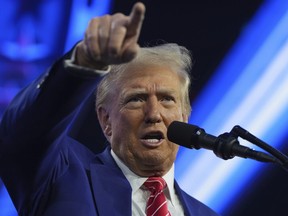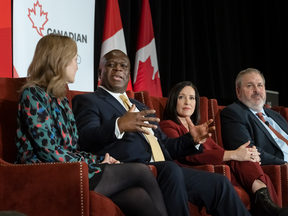Opinion: Ottawa yet to respond to threat posed by Beijing
Article content
Ask yourself this: “Why are they so cheap? Does it make sense?”
That is what I have said to everyone who has asked me about Chinese electric cars lately and the questions usually stump my audience. A lot of ink has been spilled over the promise of good quality, cheap Chinese cars, with most of the opinions being of the “bring ’em on” variety. At a time when the cost of money is still high and inflationary pressures are just coming off a generational peak, every penny counts. The idea that you could get a car like the electric BYD Seagull for less than the cost of a Honda Civic seems compelling on the surface.
Advertisement 2
Article content
Countries and companies, after all, have been falling over each other in the race electrify, part of a keeping-up-with-the-Joneses craze. The public, too, is more conscious than ever of the benefits of a smaller carbon footprint and understands that one’s choice of car may be an effective way to get there.
Still, there is a lot of debate. Electric vehicle sales have been on the rise for the last decade or so but appear to have at least momentarily plateaued. The federal government has been partnering with its counterparts in Ontario and Quebec to make massive bets on electrifying our auto sector since terms of the renegotiated NAFTA turned in Canada’s favour. However, people continue to debate whether public money is being well-spent here.
In any case, the world continues its unabated march towards a zero-emissions future. Canada, the U.S., the EU, Japan and others have declared a target of 100 per cent zero-emission vehicles (ZEV) by 2035. Volkswagen, General Motors, Honda, Ford, Stellantis, Hyundai and even Ferrari have rolled out plans for battery-electric vehicles at breakneck speed.
Article content
Advertisement 3
Article content
Unknown to many is that China has been preparing for this transition for two decades. The largest car manufacturing jurisdiction in the world — twice the size of second-place North America — is dominated by state-owned enterprises that benefit greatly from Beijing’s “Made in China 2025” industrial strategy. As part of its bid to usurp the U.S. as the world’s largest and most influential economy, the Chinese government has been pursuing a sophisticated, centrally planned, industry-wide effort to become a leader in new energy vehicles. That plan includes opaque production subsidies for all material and supplier categories, including steel and aluminum, on top of its heavily subsidized critical-minerals development strategy. As a result, China has already come to dominate the electric vehicle battery business from key inputs such as lithium to the completed battery cells being packed into cars built by automakers around the world.
Cheap labour has been another part of the equation. Last month, a rare BYD plant strike in Shanghai revealed that their employees worked 12 hours a day, six days a week for the equivalent of less than one-month’s pay in a Canadian car plant.
Advertisement 4
Article content
None of this seems to matter to many Canadians. Environmental lobbyists decried the Biden Administration’s move to introduce a 102.5 per cent tariff regime on Chinese EVs last month because they said it would stymie the effort to clean the private vehicle fleet in North America. Unfazed by the tsk-tsk’ing, the EU responded with their own 48 per cent tariff wall.
They argued that importing clean cars from the world’s worst polluter to meet a self-imposed climate target was akin to banging dry mud off your shoes in the kitchen before putting them on the clean shelf in the closet.
In Canada, we wait for the government’s response to the threat. Eighty per cent of the cars we make are destined for the U.S. market. Washington has argued that it has protected its lucrative domestic market for its market-driven allies. It has declared China a “foreign entity of concern” and banned imports and investments from getting U.S. government support. But here in Canada — where U.S. products make up 60 per cent of our imports — we are still giving Canadians who buy Teslas built in Shanghai a $5,000 federal purchase incentive.
Advertisement 5
Article content
Recommended from Editorial
-

Auto theft crisis deepens as insurance claims top $1.5 billion
-

Move over Tesla, the man who made the Bricklin is back
There are two conflicting voices coming out of Ottawa. The industry minister has worked hard to land an incredible $46 billion in electric vehicle production investments that will boost real jobs for Canadians in a strong local economy. On the other hand, the environment minister is pushing an airy ZEV mandate that plays into China’s subsidized, labour-crushing pipeline. Instead of giving Canadians a chance to fulfill the promise of making millions of electric vehicles and batteries in the next few years, the ZEV mandates feed China’s push for global economic supremacy. How would the Battle of Britain have ended if the Royal Air Force needed German engines to get airborne?
Today we wait for Ottawa’s response to the threat from Beijing. Washington and Brussels have said they want Canadian critical minerals, batteries and cars. They confirmed those orders with tariff walls and pledges of allegiance. What will Ottawa do? The clock is ticking.
Flavio Volpe is the president of the Automotive Parts Manufacturers’ Association and a Member of the Order of Canada.
Article content
Flavio Volpe: Cheap Chinese EVs come at a high cost
2024-06-20 18:38:49






